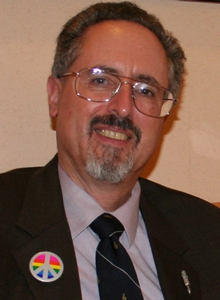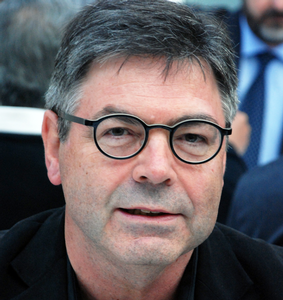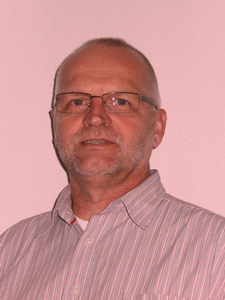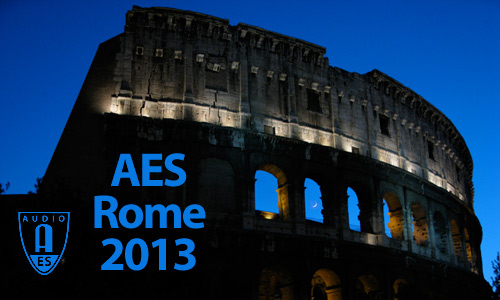
AES Rome 2013
Live Sound Track Event Details
Saturday, May 4, 10:30 — 12:30 (Auditorium Loyola)
Workshop: W1 - Capturing the Acoustics of Concert Halls with a Loudspeaker Orchestra
Chair:Tapio Lokki, Aalto University - Aalto, Finland
Panelists:
Jukka Pätynen
Sakari Tervo
Abstract:
The sensory evaluation process to assess the quality of concert hall acoustics requires that the spatial sound in a concert hall can be reproduced accurately with a multichannel reproduction system. This workshop introduces methods to create a listening system, with which a subject can switch between the acoustics of different rooms, e.g., concert halls, in real time. The acoustics is captured by measuring spatial impulse responses from 34 loudspeakers on stage with a microphone array. The impulse responses are spatially encoded for a 24-loudspeaker 3-D setup. Finally, a convolution of anechoic symphony orchestra recordings with spatially decomposed convolution reverbs reproduces the spatial sound from the concert hall for listening and for comparison of acoustics. The workshop includes several sound samples from famous European concert halls.
Saturday, May 4, 11:00 — 12:30 (Sala Alighieri)
Tutorial: T1 - Microphone Technology
Presenter:Ron Streicher, Pacific Audio-Visual Enterprises - Pasadena, CA, USA
Abstract:
How do microphones work? What differentiates one operating type of transducer from another? How and why do they sound different? What are polar patterns, and how do they affect the way a microphone responds to sound? What is “proximity effect” and why do some mics exhibit more of it than others? What’s the truth about capsule size — does it really matter? These are just a few of the topics covered in this in-depth tutorial on Microphone Technology.
Saturday, May 4, 17:00 — 18:30 (Sala Foscolo)
Tutorial: T4 - Understanding Microphone Specifications
Presenter:Eddy B. Brixen, EBB-consult - Smorum, Denmark
Abstract:
There are lots and lots of microphones available to the audio engineer. The final choice is often made on the basis of experience or perhaps just habits. (Sometimes the mic is chosen because of the looks … .) Nevertheless, there is good information to be found in the microphone specifications. This tutorial will present the most important microphone specs and provide the attendee with up-to-date information on how these specs are obtained and understood. It also takes a critical look on how specs are presented to the user, what to look for and what to expect.
This tutorial is a follow up on the project X85, which has been taking place in the AES standards committee (SC 04-04).
Sunday, May 5, 11:30 — 13:00 (Sala Manzoni)
Tutorial: T7 - Acoustic Enhancement Systems—The Basics
Presenter:Ben Kok, SCENA acoustic consultants - Uden, The Netherlands
Abstract:
In the last decades multiple systems for electronic acoustic enhancement have been introduced. Some have disappeared over time, but others appear to be settled firmly. The claim for these systems is that the acoustics of a venue can be changed at the press of a button, at cost significantly lower than variable acoustics by structural means. Also, in situations where the natural acoustics did not work out properly, these systems are used to correct the flaws, again at lower costs than the structural alternatives. The question, of course, is do these systems really work and if so, what are the differences between these systems? And what would be the structural alternatives?
This tutorial will identify what acoustic properties can or should be influenced by an acoustic enhancement system. In relation to this, working principles and philosophies of some of the most popular systems are analyzed and similarities and differences are identified and related to specific acoustic situations.
Monday, May 6, 10:00 — 11:30 (Foyer)
Poster: P13 - Room Acoustics
P13-1 The Effect of Playback System on Reverberation Level Preference—Brett Leonard, McGill University - Montreal, Quebec, Canada; The Centre for Interdisciplinary Research in Music Media and Technology - Montreal, Quebec, Canada; Richard King, McGill University - Montreal, Quebec, Canada; The Centre for Interdisciplinary Research in Music Media and Technology - Montreal, Quebec, Canada; Grzegorz Sikora, Bang & Olufsen Deutschland GmbH - Pullach, Germany
The critical role of reverberation in modern acoustic music production is undeniable. Unlike many other effects, reverberation’s spatial nature makes it extremely dependent upon the playback system over which it is experienced. While this characteristic of reverberation has been widely acknowledged among recording engineers for years, the increase in headphone listening prompts further exploration of these effects. In this study listeners are asked to add reverberation to a dry signal as presented over two different playback systems: headphones and loudspeakers. The final reverberation levels set by each subject are compared for the two monitoring systems. The resulting data show significant level differences across the two monitoring systems.
Convention Paper 8886 (Purchase now)
P13-2 Adaptation of a Large Exhibition Hall as a Concert Hall Using Simulation and Measurement Tools—Marco Facondini, TanAcoustics Studio - Pesaro (PU), Italy; Daniele Ponteggia, Studio Ing. Ponteggia - Terni (TR), Italy
Due to the growing demand of multifunctional performing spaces, there is a strong interest in the adaptation of non-dedicated spaces to host musical performances. This leads to new challenges for the acousticians with new design constraints and very tight time frames. This paper shows a practical example of the adaptation of the “Sala della Piazza” of the “Palacongressi” of Rimini. Thanks to the combined use of prediction and measurement tools it has been possible to design the acoustical treatments with a high degree of accuracy, reaching all targets and at the same time respecting the tight deadlines.
Convention Paper 8887 (Purchase now)
P13-3 Digital Filter for Modeling Air Absorption in Real Time—Carlo Petruzzellis, ZP Engineering S.r.L. - Rome, Italy; Umberto Zanghieri, ZP Engineering S.r.L. - Rome, Italy
Sound atmospheric attenuation is a relevant aspect of realistic space modeling in 3-D audio simulation systems. A digital filter has been developed on commercial DSP processors to match air absorption curves. This paper focuses on the algorithm implementation of a digital filter with continuous roll-off control, to simulate high frequency damping of audio signals in various atmospheric conditions, along with rules to allow a precise approximation of the behavior described by analytical formulas.
Convention Paper 8888 (Purchase now)
P13-4 Development of Multipoint Mixed-Phase Equalization System for Multiple Environments—Stefania Cecchi, Universitá Politecnica della Marche - Ancona, Italy; Marco Virgulti, Universitá Politecnica della Marche - Ancona, Italy; Stefano Doria, Leaff Engineering - Ancona, Italy; Ferruccio Bettarelli, Leaff Engineering - Ancona, Italy; Francesco Piazza, Universitá Politecnica della Marche - Ancona (AN), Italy
The development of a mixed-phase equalizer is still an open problem in the field of room response equalization. In this context, a multipoint mixed-phased impulse response equalization system is presented taking into consideration a magnitude equalization procedure based on a time-frequency segmentation of the impulse responses and a phase equalization technique based on the group delay analysis. Furthermore, an automatic software tool for the measurement of the environment impulse responses and for the design of a suitable equalizer is presented. Taking advantage of this tool, several tests have been performed considering objective and subjective analysis applied in a real environment and comparing the obtained results with different approaches.
Convention Paper 8889 (Purchase now)
P13-5 Acoustics Modernization of the Recording Studio in Wroclaw University of Technology—Magdalena Kaminska, Wroclaw University of Technology - Wroclaw, Poland; Patryk Kobylt, Wroclaw University of Technology - Wroclaw, Poland; Bartlomiej Kruk, Wroclaw University of Technology - Wroclaw, Poland; Jan Sokolnicki, Wroclaw University of Technology - Wroclaw, Poland
The aim of this paper is to present results of the acoustic modernization at the Wroclaw University of Technology recording studio. During the project realization, the focus is on the problem arising in one part of the recording studio—the so-called flutter echoes phenomenon. To minimize this effect we present a several-stage process in which the studio is accommodated to expect this occurrence. The first step was to make some measurements of acoustic properties in the room with the concentration on the previously mentioned effect. Next, a one-dimension diffuser was designed and placed in the phenomenon incidence. The last stage of the research was an acoustic measurement after modification and comparison with the properties before the changes.
Convention Paper 8890 (Purchase now)
P13-6 Accurate Acoustic Echo Reduction with Residual Echo Power Estimation for Long Reverberation—Masahiro Fukui, NTT Corporation - Musashino-shi, Tokyo, Japan; Suehiro Shimauchi, NTT Corporation - Musashino-shi, Tokyo, Japan; Yusuki Hioka, University of Canterbury - Christchurch, New Zealand; Hitoshi Ohmuro, NTT Corporation - Musashino-shi, Tokyo, Japan; Yoichi Haneda, The University of Electro-Communications - Chofu-shi, Tokyo, Japan
This paper deals with the problem of estimating and reducing residual echo components that result from reverberant components beyond the length of FFT block. The residual echo reduction process suppresses the residual echo by applying a multiplicative gain calculated from the estimated echo power spectrum. However, the estimated power spectrum reproduces only a fraction of the echo-path impulse response and so all the reverberant component are not considered. To address this problem we introduce a finite nonnegative convolution method by which each segment of echo-impulse response is convoluted with a received signal in a power spectral domain. With the proposed method, the power spectra of each segment of echo-impulse response are collectively estimated by solving the least-mean-squares problem between the microphone and the estimated-residual-echo power spectra. The performance of this method was demonstrated by simulation results in which speech distortions were decreased compared with the conventional method.
Convention Paper 8891 (Purchase now)
Monday, May 6, 14:15 — 16:15 (Sala Alighieri)
Tutorial: T14 - Rub & Buzz and Other Irregular Loudspeaker Distortion
Presenter:Wolfgang Klippel, Klippel GmbH - Dresden, Germany
Abstract:
Loudspeaker defects caused by manufacturing, aging, overload, or climate impact generate a special kind of irregular distortion commonly known as rub & buzz, which are highly audible and intolerable for the human ear. Contrary to regular loudspeaker distortions defined in the design process, the irregular distortions are hardly predictable and are generated by an independent process triggered by the input signal. Traditional distortion measurements such as THD fail in the reliable detection of those defects. This tutorial discusses the most important defect classes, new measurement techniques, audibility, and the impact on perceived sound quality.
Tuesday, May 7, 09:00 — 11:30 (Auditorium Loyola)
Workshop: W9 - Acoustic Enhancements Systems—Implementations
Chair:Ben Kok, SCENA acoustic consultants - Uden, The Netherlands
Panelists:
Steve Barbar, E-coustic Systems - Belmont, MA, USA
Peter Mapp, Peter Mapp Associates - Colchester, Essex, UK
Thomas Sporer, Fraunhofer IDMT - Ilmenau, Germany
Takayuki Watanabe, Yamaha Corp. - Hamamatsu, Shizuoka, Japan
Wieslaw Woszczyk, McGill University - Montreal, QC, Canada
Abstract:
Acoustic enhancement systems offer the possibility to change the acoustics of a venue by electronic means. The way how this is achieved varies by the working principle and philosophy of the system implemented. In this workshop various researchers, consultants, and suppliers active in the field of enhancement systems will discuss working principles and implementations.
This workshop is in close relation with the tutorial on acoustic enhancement systems; people not yet too familiar with the applications and working principles of these systems are recommended to attend the tutorial before attending the workshop.
Tuesday, May 7, 11:45 — 13:15 (Auditorium Loyola)
Tutorial: T16 - Microphones: The Physics, Metaphysics, and Philosophy
Presenter:Ron Streicher, Pacific Audio-Visual Enterprises - Pasadena, CA, USA
Abstract:
Before you can place the first microphone in the studio, you need to develop a clear understanding of the sound that you want to emanate from the loudspeakers when the project is finished. To do this, you need to determine what are the elements that are essential for creating the “sonic illusion,” and then decide how to balance the often conflicting elements and competing demands of technology vs. art. Microphone techniques—although critical—are only a part of this process. Equally important are the criteria for monitoring and evaluating the results. Using recorded examples and practical demonstrations, the various aspects of this creative process are developed and brought into focus.
Tuesday, May 7, 14:30 — 16:30 (Sala Foscolo)
Workshop: W10 - Miking for PA
Chair:Eddy B. Brixen, EBB-consult - Smorum, Denmark
Panelists:
Giacome De Caterini, Casal Bauer - Italy
Igor Fiorini, VDM Group - Italy
Cathrine Sadolin, Complete Vocal Institute - Copenhagen, Denmark
Henrik Sadolin, Complete Vocal Institute - Copenhagen, Denmark
Abstract:
Miking for PA is a very important task. Providing amplification to the spoken or singing voice or the acoustical music instrument requires good knowledge about the sound source, about the PA-system, about the monitoring system—and about the microphones. This workshop takes you through some of the important issues and decisions when selecting the microphone with regards to peak level capacity, sensitivity, directivity, frequency response, sensitivity, etc. Getting balance, getting definition, getting the right timbre or “sound”—and still avoiding acoustical feedback, that’s the thing. Recognized engineers and sound designers will generously share their experiences from their work on the stages. Warning: Some of the attendees may pick up ideas that will change their habits forever…




